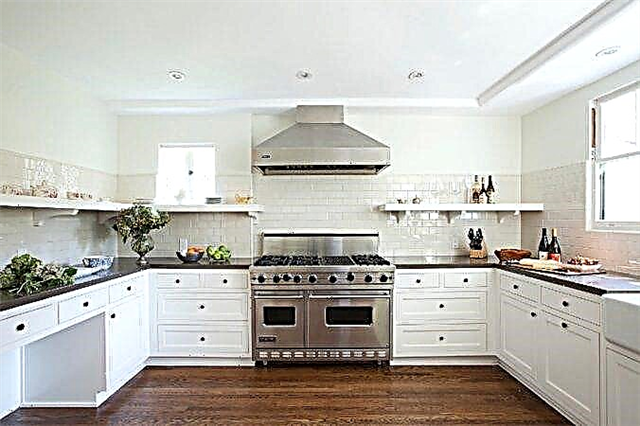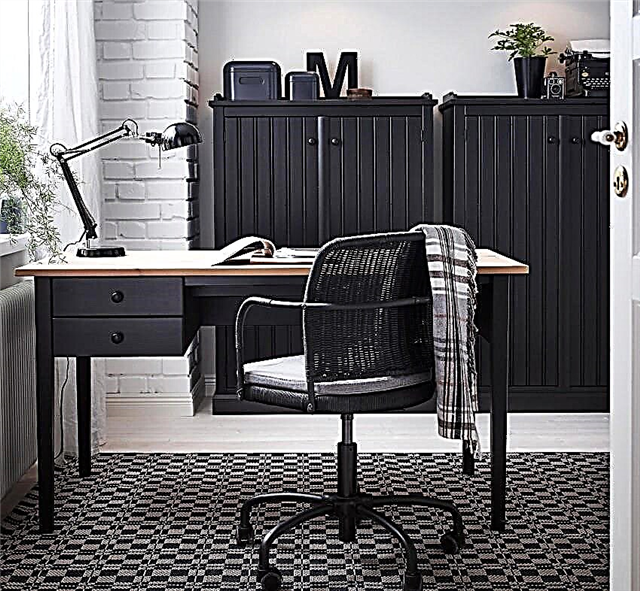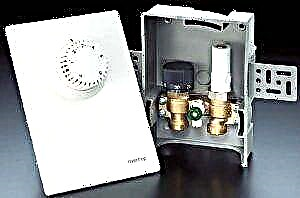It turns out that with a certain imagination and a little skill, your interior can change its “appearance” depending on the time of day. For example, during the day everything will be in a classic strict version, and when dark, it will be transformed into a luminous fantastic palace.
Luminescence is the ability of a material to emit light in the dark or under certain artificial lighting. Such an unusual special effect can be achieved from any object, it is enough to process it with luminous paint.
Any plane can be treated with fluorescent paint, which allows you to create a unique design even without the help of specialists.
Glowing paint is quite an expensive pleasure and not everyone can afford it. Therefore, a great solution would be a paint made at home. In terms of its parameters, it will not differ from the factory one. However, you will have to spend time on its manufacture and on the acquisition of the necessary components.

Properties of luminous paint
One of the most common varieties of luminous paints is produced with the participation of a phosphor - a harmless phosphorescent pigment.
The constituent elements of the paint are completely harmless, but you need to purchase components for its preparation at home from manufacturers who have a certificate of quality.
Luminous paint is formed from two main components: varnish and phosphor pigment. The properties of the phosphor are determined by the feature of light emission. The composition of this mixture includes oxides and lanthanides, which act as hypostases of activators.
The phosphor can accumulate light, and then gives off this energy in the form of a glow. It can produce a charge resource from any solar or ultraviolet base. Enough 15 minutes in daylight or artificial lighting and this stock is enough for the relentless glow of a painted object for 7 hours.
The most amazing thing is that this process dominates the non-stop cycle and can work in this mode for about 30 years.
Among other things, the luminous element perfectly adapts to the environment from the outside, it tolerates frosty weather well, so it can be used both indoors and outdoors.
Among the shades of luminescent colors, yellow and blue prevail. But with certain manipulations, you can get other colors. The powder of light green color has the brightest radiance, which in the daytime looks like light green.
Some designers use this material for the original interior in a room with tiles. They are made from improvised means and used as grout for joints, which not only glows in a dark room, but also protects from moisture.
Luminous neon paint for metal looks cool on the wheels of a car, it is also used in airbrushing and in the design of front doors of buildings or on metal signs.
Using this unusual material, you can create exotic effects on any texture, be it stone, concrete floor, plastic windows or other surfaces. The main thing is that the plane is clean and dry. Before applying, degrease it, remove dust and dirt from the surface.
With this extraordinary paint, you can do extraordinary things in phytodesign. Since the colorful material dries quickly, it can be safely applied to fresh flowers, indoor plants or to branches of any tree. Manufacturers guarantee safety, so the color is harmless to plants.
Glass surfaces that are treated with a luminescent color shine especially intensely in the dark. This approach is used in the manufacture of shop windows. You can also stain small glassware, such as a countertop, cabinet shelf, lampshade, or vase.
How to make a luminous paint at home?
It is not difficult to prepare a phosphor at home. To do this, you need to purchase coniferous concentrate, which can be bought at a pharmacy. Pour or pour (if the substance is in a liquid state) into the dishes concentrate. After we add a small amount of water. Thus, we obtain liquid tartrazine.
Tartrazine is a synthetic dye with a characteristic yellow color. It refers to food.
Then thoroughly mix the resulting mass until smooth. Put the dishes with the mixture on the fire and heat it. When heated, air bubbles form that need to be pierced with a sharp object. The next step is to cool the mixture, pour in tartrazine again and warm up. After completion of the procedure, a homogeneous substance of yellow color is obtained.
To verify the result, the resulting mass must be illuminated with a bright flash. If everything is done correctly, a glow will be noticeable. The resulting phosphor substance can be crushed into powder, grinding it. You can read more about the process in a thematic video.
Recipe for improved phosphor:
DIY fluorescent paint
The fluorescent paint is popularly called ultraviolet. The main difference with fluorescent is that it does not emit light in the dark. It is possible to manifest its property only with the help of neon ultraviolet, and in the daytime the drawing applied by it does not differ from ordinary.
It consists of a transparent base with a fluorescent pigment, a thermoplastic resin and a powdery dye, but despite its rich chemical composition, it is non-toxic.
Among the huge gamut of colors of UV paint, the most popular, such as red, yellow, pink and green, can be distinguished, their prevalence is explained by the fact that even in low light they show their effect.
Fluorescent paint is applied on any basis: metal products, wood, ceramic. You can also process fresh flowers and even use for drawings on the body. Some designers use this outlandish material in landscaping.
They make a fluorescent color from safe substances for humans, so they are used by body art masters. Dyes are practically not absorbed into the body. For lovers of nightclubs produce whole sets. The only drawback is that you have to wash off the substance after the end of the holiday.
It is also worth noting the fact that luminous fluorescent dye is used in the manufacture of wallpaper. With the help of such technology, you can transform a children's room. In daylight, the wallpaper serves as a regular coating with different thematic patterns, and when the neon lights turn on, their bulk surprises even adults.
They are glued to a flat surface, as well as ordinary wallpaper. But it is worth warning that the desired effect is achieved only with the help of ultraviolet lamps and neon lighting.
There is the easiest way to make fluorescent paint. To obtain it, you will need several components: colorless acrylic varnish and fluorescent powder. But not one hundred percent fluorophore, which is very decent, but its pigment with a polymer base. You can buy it in a special store or on the Internet.
To obtain the necessary composition, the acquired pigment is poured into the base of acrylic and carefully mixed. If you add the pigment of the desired color to the emulsion, it also needs to be mixed well.
What is fluorescent paint and how does it work?
Luminescence is the ability of a substance to glow in the dark due to previously accumulated light energy. In luminescent paint, there are substances such as luminous pigments (phosphors). They “accumulate light” for a day or while artificial lighting is on. And when darkness comes, a bright glow of the painted surface becomes noticeable.
Important! Do not confuse luminescent (phosphor, self-luminous) compositions with fluorescent paints. The latter can glow only under the influence of ultraviolet rays (you need to buy special lamps for them).
The process of accumulation and return of light energy by a phosphor is reversible, therefore, luminous paint will “work” for years. Phosphor is a physically and chemically stable substance that will last at least 30 years, even outside the building. At the same time, only 15–20 minutes of “recharging” with bright light is enough for the painted surface to glow for about 8 hours. The brightness of the glow depends on the concentration of the phosphor in the paint.
According to the principle of action, luminescent materials are similar to phosphorescent ones. But the latter contain hazardous phosphorus. Therefore, they are used very rarely and only for outdoor work. But phosphor-based materials are completely safe.
Scope of luminous paints
In addition to the phosphor itself, transparent lacquer enters the luminous paint (it acts as the basis of the material). The area of application of a particular composition depends on the properties of the varnish. It can be selected for almost any surface - metal and plastic, drywall and wallpaper, concrete and plaster, textiles and wood, glass and ceramics.
On a note! The luminous composition can be applied to fresh flowers and used for body art. But it must be a water-based acrylic dispersion that is safe for health.
Luminescent paint is used:
- when applying road marking, painting fences and road signs,
- for a decor of internal surfaces (drawing drawings on walls, ceilings, floors),
- for painting furniture and other interior elements,
- in makeup, stage art, while creating theatrical costumes and scenery,
- in floristry,
- in the manufacture of promotional products (from signage to souvenirs),
- in landscape design (from painting arbors and fences to creating complex drawings on facades),
- in tuning cars, bicycles, motorcycles (for airbrushing, painting discs, caps, bumpers, spoilers),
- for the production of overalls for workers of road and emergency services.
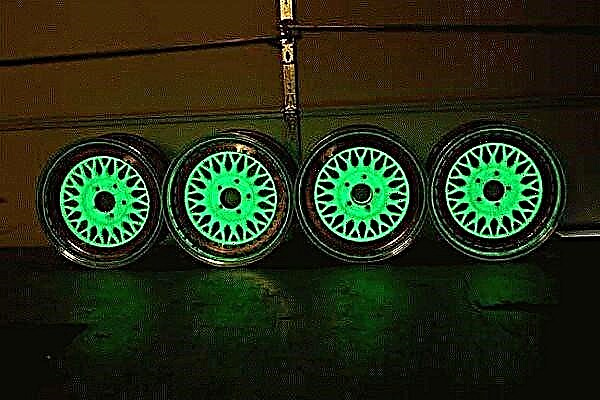 Car tuning - one of the areas of application of luminous paint
Car tuning - one of the areas of application of luminous paintTypes of fluorescent paint
All compounds on the market can be divided into two large groups:
- Colorless (or translucent). These are varnishes that are almost invisible in daylight. They can be applied over any “visible” pattern.
- Colored. These enamels, in addition to the phosphor, incorporate a coloring pigment (color). During the day they look like ordinary paints, and at night they glow.
 A large assortment of fluorescent paint is available on the market.
A large assortment of fluorescent paint is available on the market.Also, luminescent coatings differ in the composition of the base and operational properties. Among them are:
- Polyurethane-mineral enamels. They have high adhesion and are suitable for coloring various plastics.
- Water-dispersed (acrylic) emulsions. Safe and quick to dry.
- Heat resistant paints. Create coatings that withstand heat up to +500 ° C. Good for painting metal structures, glass, ceramics.
- Water resistant compounds. Create a thin waterproof film on the painted surface. They are used for painting pools, drains, elements of bathrooms.
How to prepare a luminous paint from a phosphor powder?
You can make a paint with a glow effect with your own hands. To do this, you need to buy a phosphor, choose a transparent varnish and a solvent for it. You will also need ceramic or glassware to mix the ingredients.
The phosphor of the desired color can be found on the Internet or in a building materials store. It is quite expensive, but 100 g of this powder is enough for continuous staining of about 8 square meters. m surface. The price depends on the color of the glow: light green, blue and white pigments are cheaper, but brighter ones - red, orange, blue, green - are more expensive.
 Phosphor - luminous powder for the manufacture of luminescent paint
Phosphor - luminous powder for the manufacture of luminescent paint
Important! Varnish should be chosen for the surface that will be painted. Only in this way the finished paint will hold well.
How to make a luminous paint at home:
- Pour the varnish into the dishes.
- Add powder phosphor (the ratio is considered ideal when the composition is 70% lacquer and 30% luminous pigment).
- Add a little solvent to the mixture (up to 1% of the total mass).
- Stir well.
- If you want to get a colored composition, color is also added to the dishes.
 Materials and tools necessary for the preparation of fluorescent paint
Materials and tools necessary for the preparation of fluorescent paint The paint made in this way is used and stored in the same way as regular varnish of a similar type.
Self-made phosphor
With a strong desire, you can prepare a phosphor with your own hands. True, this will require more effort and special reagents. What do we have to do:
- Take coniferous concentrate and dissolve it in clean water in a ratio of 1: 50. The finished solution should have a yellow tint.
- Pour 2-3 g of boric acid into a heat-resistant dish with a wide bottom.
- To drip on a powder about 10 drops of coniferous solution.
 Coniferous concentrate - the main component that affects the glow of homemade phosphor
Coniferous concentrate - the main component that affects the glow of homemade phosphor
On a note! The color and luminosity of the resulting phosphor will depend on the concentration of coniferous extract. Therefore, it can be varied to achieve the desired effect.
Before making a phosphor, you need to calculate the required amount of luminous paint. It is possible that it will be easier and cheaper to buy finished material in the store. In addition, the “proprietary” paint will always be better than artisanal, and the color of the glow can be selected immediately, without lengthy experiments. And having one or several jars of luminescent paint in your arsenal, it is easy to create an unusual thing, stylish tuning or a unique interior.
What are luminous colors?
Having decided with your own hands to make a luminous coloring composition, you need to find out what components it can contain and how it works. There are several types of paints that emit light in the dark: luminescent, fluorescent, phosphoric, reflective. They differ from each other by the principle of luminescence, which depends on the components that make up their composition.
The principle of luminescence of luminescent paint
Luminescence is the luminescence of matter without heat as a result of the accumulation of light energy. Luminescent paints glow in the absence of any light sources due to the content of special components - phosphors. These luminous pigments in the daylight accumulate light. At the same time, they are "charged" from sources of not only natural light, but also artificial. At dusk, these substances begin to glow. The brightness of the emitted light depends on their concentration in the composition of the dye product.
This type of paints and varnishes (LKM) is absolutely harmless to health. Luminescent paints are colorless (translucent) and colored. They are suitable for coloring:
- metal, glass, ceramic surfaces (heat-resistant coatings),
- fabrics (contain acrylic varnish),
- plants (water-based coatings)
- tree
- concrete
- plastic (polyurethane-mineral enamel).
Why is fluorescent composition glowing?
This kind of luminous paint is able to glow in the dark only under the influence of ultraviolet light. The coating painted by it absorbs UV rays incident on it, converting them into visible radiation with longer waves. Fluorescent coatings glow only with current sources of ultraviolet radiation.When they are turned off, this is a normal, not at all luminous, coloring composition, therefore it is also called invisible or ultraviolet.
The ability of this paint to emit light is based on the principle of fluorescence (fluorescence). This term refers to a phenomenon in which a molecule, absorbing light of a certain wavelength, emits light of a longer wavelength. This type of paintwork is illuminated due to the special pigments of fluorophores that are part of it and capable of fluorescence.
Rhodamine, cyanine, and aminonaphthalimide derivatives are commonly used as these components. These substances are very expensive, therefore, to reduce the cost of the manufacturing process of the coloring composition they paint the smallest polymer particles, which are then added to the base of the product.
Phosphoric (phosphorescent) should be distinguished from fluorescent coatings. Due to the phosphorus content, they are unsafe for human health, therefore they are rarely used. Usually they are used for outdoor work, for example for painting a car.
How does reflective paint work?
The group of reflective (or retroreflective) paints differs from the previous, luminous, types of coatings, the glow principle of which depends on the ingredients that can glow in the dark. With some stretch, fluorescent materials can be attributed to them, but they are able to reflect only UV rays.
The paint acquires the ability to return light after the addition of tiny (150-500 microns) glass balls. Thanks to them, the surface painted with reflective paint reflects any light rays that fall on it.
What are the phosphors?
It is not necessary to know the basics of chemistry in order to have an idea about phosphors. The main characteristic of these substances is absorption spectra, which reflect the dependence of the amount of absorbed light energy on the wavelength of the light incident on them. They depend on the chemical origin of the activator and the basis of the pigment, their interaction, and if we are talking about phosphors with more than one activator, then on their contact with each other. The emission spectra are affected by the intensity and wavelength of the exciting light, as well as the temperature.
Substances aimed at the formation of a glow under various kinds of influences are divided into many types. Information on the classification of phosphors is presented in the table:
Phosphors| Classification principle | Varieties of phosphors | |
| Chemical origin | Inorganic (phosphorus). Most of them relate to crystallophosphors. Used for the production of luminescent light sources, cathode ray tubes, X-ray screens, serve as indicators of the level of radiation background, etc. | |
| Organic (organoluminophores, lumogens). They are used for the manufacture of fluorescent coatings for dyeing textile and plastic products, jewelry, printing inks, for pigmentation of polymer clay, wallpaper, tattoos, cosmetics, luminescent materials. It is used to detect cracks in the details when performing analyzes based on the luminescence phenomenon and used in various fields. | ||
| The method of excitation of luminescence | Ultraviolet radiation | Photophosphors |
| Electron beams | Cathodoluminophors | |
| Electric field | Electroluminophores | |
| Alpha and betto radiation of radioactive waves | Radiophosphors | |
| X-ray and gamma radiation | X-ray phosphors | |
| Features of processes that provoke radiation | Intracenter (non-conductive phosphors are used, or substances with discrete centers) | |
| Recombination (photoconductive pigments are used) | ||
| Glow duration | Fast fading | |
| Fast | ||
How to make a glowing in the dark paint yourself?
The easiest way to prepare a home-made neon paint using a ready-made phosphor. To make yourself a glowing composition in the dark, you will need:
- Transparent varnish, which must be selected based on the characteristics of the surface to be painted.
- Solvent.
- Phosphor. This substance is sold in powder form in almost any hardware store. Its cost depends on the shade. Usually bright powders are more expensive than analogues of pastel colors.
- Capacity for the preparation of a coloring composition. It is better to use glass or ceramic dishes.
Stages of independent production of luminous paintwork:
- Pour varnish into the container.
- Pour luminescent powder into it. The optimal ratio of varnish and pigment is 7: 3.
- Add solvent to the mass. It should be no more than 1% of the total amount of solution.
- Thoroughly mix the components and, if necessary, add the pigment of the desired shade.
Is it possible to make paint at home that glows without a phosphor?
In order to prepare such a composition at home, it is not necessary to use a luminescent powder. To prepare it, you can use the available components. There are several ways to make a homemade glow in the dark coloring agent. A detailed description of how and from which ingredients to make it:
| Components | Number of ingredients | Preparation of a coloring composition emitting light in the dark |
| Luminous marker or felt-tip pen | 1 PC. | Check if the writing and drawing tool is operational. To do this, draw them a few lines on paper. If they emit light in the dark, then a felt-tip pen can be used. After taking the rod out of it, hold it in water, then squeeze it well. Mix colored liquid with water-based varnish. |
| Coniferous Concentrate | 3 g | Add the needles concentrate to the aluminum container with water. Pour boric acid into another bowl. Pour half of the coniferous solution into it with a thin stream. Boil the mixture and cool completely. Add the remaining coniferous solution to it and bring the liquid to a boil. The resulting yellowish mass will serve as a luminescent component. To obtain a luminous paintwork, mix the yellow solution with paint. |
| Boric acid | Pinch | |
| Water | 50 ml | |
| Hydrogen peroxide | 1 tbsp. l | Add the rest of the ingredients to the glass jar with warm water. After closing it with a lid, shake it well until its contents begin to emit a slight glow. |
| Water | 150 ml | |
| Vinegar | 0.5 tbsp. l | |
| Salt | Pinch | |
| Luminol (white or yellowish crystals) | 0.15 g | Mix all the ingredients in a glass jar. After closing it with a lid, shake it until its contents turn blue. |
| Alkali | 35 g | |
| Dimexide (a clear, colorless solution with a mild odor, used for medicinal purposes) | 30 ml |
The proportions of ingredients given in the table allow you to make paint with a delicate glow. To create a coloring product with intense radiance, you need to double the number of components.
In the process, it is recommended to observe 3 basic rules:
- work in rubber gloves so as not to get your hands dirty,
- when using sharply smelling substances, wear a respirator and safety glasses, preparing paint in a well-ventilated area,
- work in old clothes that can be thrown away if they get dirty.
I hope the material presented is enough to prepare a luminous paint for your own purposes. The following video will complement the above.
Fluorescent paint, types and properties
Luminescent paint is divided into two groups: color and colorless:
- Color enamel. It shines at night, and during the day it looks like a simple paint. It includes a phosphor and color.
- Colorless varnish. The painted surface with a colorless or translucent varnish in the daytime is almost invisible, and in the dark it glows with a yellow or blue tint. It is applied on top of any picture.
Luminescent paint has different performance characteristics due to its base and is divided into several types, these are:
- Water based paints. Such a composition is used in rooms with high humidity (bathroom, pool, etc.). Having painted the room with waterproof paint, a waterproof film is created on the surface.
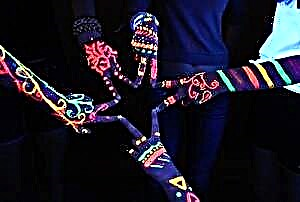 Acrylic Emulsions. Advantages of water-dispersed emulsions: dry quickly and are safe for human health.
Acrylic Emulsions. Advantages of water-dispersed emulsions: dry quickly and are safe for human health.- Heat Resistant Compounds. Used for painting glass, ceramic and metal surfaces. Covered surfaces with heat-resistant compounds withstand temperatures up to + 500 degrees.
- Polyurethane-mineral enamels. Designed for plastic products, have increased adhesion.
Light green - yellow pigment looks pale during the day, and in the dark it has the brightest glow of all shades.
The composition of the luminous paint, the principle of operation
Luminous paint consists of varnish and luminescent pigment (phosphor). The principle of its operation is simple: the phosphor, having accumulated light during the day from external sources, begins to give it at night, giving any painted surface a bright glow. Depending on the saturation of the ink with a phosphor it depends on how bright the glow will be, the higher its concentration, the object shines brighter. To accumulate energy, 20 minutes are enough, the surface will glow up to 8 hours.
 Unlike phosphor enamels, which are charged from any lighting, fluorescent ones work only from ultraviolet rays or special lamps are purchased to charge them. The paint glowing in the dark with the phosphor content is non-toxic, non-flammable and completely safe for humans, its service life is 30 years. Phosphorescent compounds contain phosphorus and work on the same principle, but they are rarely used and are used only for outdoor decoration, since phosphorus is hazardous to health.
Unlike phosphor enamels, which are charged from any lighting, fluorescent ones work only from ultraviolet rays or special lamps are purchased to charge them. The paint glowing in the dark with the phosphor content is non-toxic, non-flammable and completely safe for humans, its service life is 30 years. Phosphorescent compounds contain phosphorus and work on the same principle, but they are rarely used and are used only for outdoor decoration, since phosphorus is hazardous to health.
What is luminous paint, types and principle of operation
You can create a cozy atmosphere in the room and arrange the interior, regardless of the time of day or lighting, if you use luminous paint. Often use decor in children's rooms, so that the child is not afraid to sleep at night in the dark without the use of additional nightlights, as it is not always safe.
Using this tool, you can apply any pattern to walls, ceilings or furniture. It’s convenient to work with the composition, as well as regular paint. But at night such drawings look spectacular.
Luminous paint has two types:
- Luminescent. Glow on its own when the room begins to get dark, it does not need additional equipment.
- Fluorescent. Glowing is also bright, but for this you need to direct the ultraviolet rays of a special device on it, without which it will look like a regular dye.
Luminescent paint at home is used more often, since it creates a bright glow in the room spontaneously. As soon as the sun begins to set, it becomes brighter and in complete darkness all the drawings are fully visible.
The work of the tool is the presence in its composition of special pigments - phosphors. They attract, accumulate light energy during the day, and reflect it in the dark, creating a bright glow. They accumulate not only the energy of sunlight, they can be “charged” using artificial lighting, or even moonlight.
Both types can be used, however, fluorescent liquid can be hazardous to health due to the released enzymes when exposed to ultraviolet radiation, so it is better to use it outside the building.
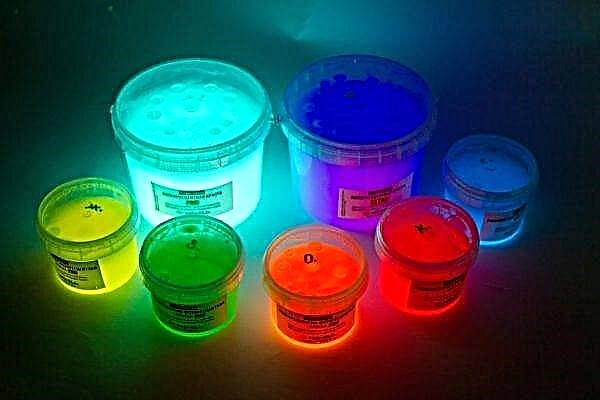
Are these paints safe for health?
Before you make a luminous paint at home, you should consider its safety and scope. Since for one of the species a prerequisite is ultraviolet exposure, it is not always recommended to use funds at home.
The composition of fluorescent paint includes phosphorus, if an increased amount of it enters the respiratory tract of a person, it can cause health problems, which is why its use in poorly ventilated rooms is dangerous. In any case, it is better to limit its use for interior decoration.
But the main component of the luminescent dye is phosphors, the bulk of which is transparent varnish. Because of this, after applying the solution in the room, it is enough to ventilate it well, after that this finishing option will be absolutely safe for the human body, regardless of its age.
However, keep in mind that allergic reactions to individual components of luminous paint are rare, which may make its use not entirely safe.
Luminous phosphor paint
Phosphor paint is safer since it does not emit enzymes harmful to the respiratory tract. In addition, it does not require exposure to ultraviolet radiation, which makes its use easier.
The phosphor itself contains a transparent lacquer, which makes it safe for health. The substance attracts and retains light, reflecting it in the dark. This allows you to create a glow picture.
The glow is preserved for a long time. After two hours of collecting light energy, the pattern drawn by the luminescent dye reflects it during the day.
How to make a phosphor with your own hands
You can independently create a luminescent paint, which will spontaneously collect, and reflect light in the dark. According to its technical characteristics, it will be similar to the store version, it also retains the glow for as long.
There are several recipes with which you can make a luminous solution:
- Recipe 1. For it, you need to mix one glass of warm water and two tablespoons of hydrogen peroxide. Add two teaspoons of table vinegar and a little salt to the liquid. Mix the solution thoroughly, it is better to do it quickly - you can close the container with a tight lid and shake it. The resulting luminous liquid can be dyed or applied to the walls. If you use double proportions of additional components (except water), you can increase the concentration and glow.
- Recipe 2. If you have a luminous marker, you can use it. To do this, gently unwind it, remove the rod and dissolve its dye in a small amount of water. After that, the resulting water can be mixed with ordinary coloring pigment for decoration. Take as little water as possible to prevent impaired resistance and performance after dilution.
- Recipe 3. Take two tablespoons of water and mix them with three grams of pine needles concentrate, dissolving it to a uniform consistency. Mix a pinch of boric acid with half the resulting liquid and bring the mixture to a boil. After the solution has completely cooled, add the other half of concentrated water and boil again. The resulting solution will play the role of a phosphor, which can be mixed with a conventional dye and used as a luminous dye.
Before you make a glowing paint, it is recommended to protect your eyes and hands, as some components can be harmful. It is important to strictly observe safety precautions and proportions, so you get a luminous liquid quickly enough.
Regardless of the option used, the resulting phosphor must be mixed with standard paint for interior or exterior decoration. But keep in mind - you do not need to dilute the dye strongly with the resulting liquid, since its quality can be degraded, it will become too liquid and will look bad in the form of decor.
Paint Tips
Regardless of whether you made the fluorescent paint yourself, or bought ready-made, when using it, it is recommended to consider some tips. They will facilitate the application of the solution, providing a positive result.
There are many recommendations for applying the composition, regardless of coating:
- Protect your eyes and breathing when working with the solution. If it gets into your mouth or eyes, rinse the affected area with plenty of water immediately and then consult a doctor.
- Regardless of the type of composition, it must be used in a well-ventilated area with constantly open windows.
- When using the finished product, before using it, mix thoroughly to combine the sediment of their phosphor with the main composition.
- To make the result look more effective, it is better to apply two layers of solution. However, after the first coat, allow the solution to solidify for two hours.
- Prepare the surface before painting. To do this, make sure that it is completely even and dry, you can additionally cover it with a white primer on top to make the dye more comfortable.
Observing the recommendations for applying the dye, you will get an effective result, without harm to your health or safety violations of the use of the premises.
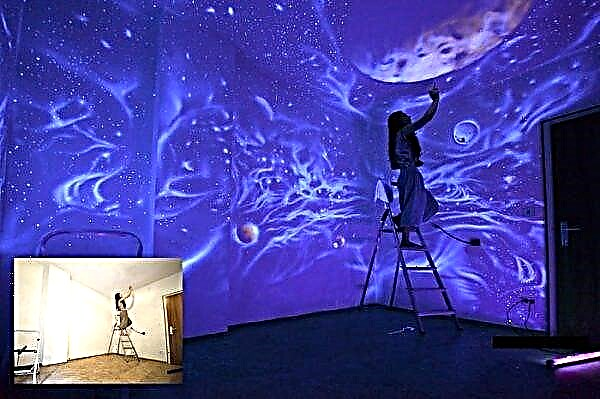
Making luminous paint with your own hands from a phosphor
To create a paint with your own hands with a glow effect, you will need a glass or ceramic container, varnish, solvent for varnish, phosphor. To keep the enamel well, choose a varnish that matches your surface. The phosphor is purchased in stores for artists or on the Internet. Light shades of powder are cheaper, it is white, light green, blue, pink. Bright, saturated colors are more expensive, it is red, green, blue. Despite the fact that the cost of the phosphor is quite large for a surface of up to 8 square meters. m. enough 100 gr. powder. To make transparent enamel you need:
- Pour 70% of the varnish into the container by adding a phosphor of 30%,
- Add up to 1% solvent to the finished mass, so the phosphor will be better distributed,
- Mix everything thoroughly to get a homogeneous substance,
- When adding color to the mass, a shade will appear on the surface.
The prepared enamel is stored and used in the same way as the varnish on the basis of which it was made.
Where can luminous paints be used?
Suitable for wallpaper, plaster, glass and ceramics, for metal and plastic surfaces. She is heat-resistant, not afraid of frost, it is used for interior and exterior decoration, this:
- Walls, ceilings and floor (starry sky, paintings, patterns, graffiti).
- Sometimes various interior elements are painted: furniture, window frames, doors, cabinets.
- Road signs and fences.
- Advertising signs.
- Decorate theatrical scenery.
- Make-up and manicure with a glowing effect (body art).
- Bicycles, motorcycles and cars.
- In landscape design (fences, gates, etc.).
Basic Tips for Glowing Inks
When working with luminous paints, you should adhere to some recommendations:
- Phosphorus is hazardous to health, so the room in which the phosphorus compound is painted should be well ventilated.
- If vapors get into the respiratory tract, consult a doctor.
- It is necessary to observe safety measures and work only with gloves, goggles and a respirator.
- In order for the enamel layer to lie evenly, the surface on which it is applied must be smooth and dry.
- Sometimes a sediment from the phosphor appears at the bottom of the can of paint, so when starting work, the paint is thoroughly mixed.
- After applying the first coat to the surface, wait 1.5 hours and then apply the second coat of paint.
- To give a product a brighter glow will help previously applied to it white soil, since a dark surface will absorb the radiated energy.

 Coniferous concentrate - the main component that affects the glow of homemade phosphor
Coniferous concentrate - the main component that affects the glow of homemade phosphor Acrylic Emulsions. Advantages of water-dispersed emulsions: dry quickly and are safe for human health.
Acrylic Emulsions. Advantages of water-dispersed emulsions: dry quickly and are safe for human health.